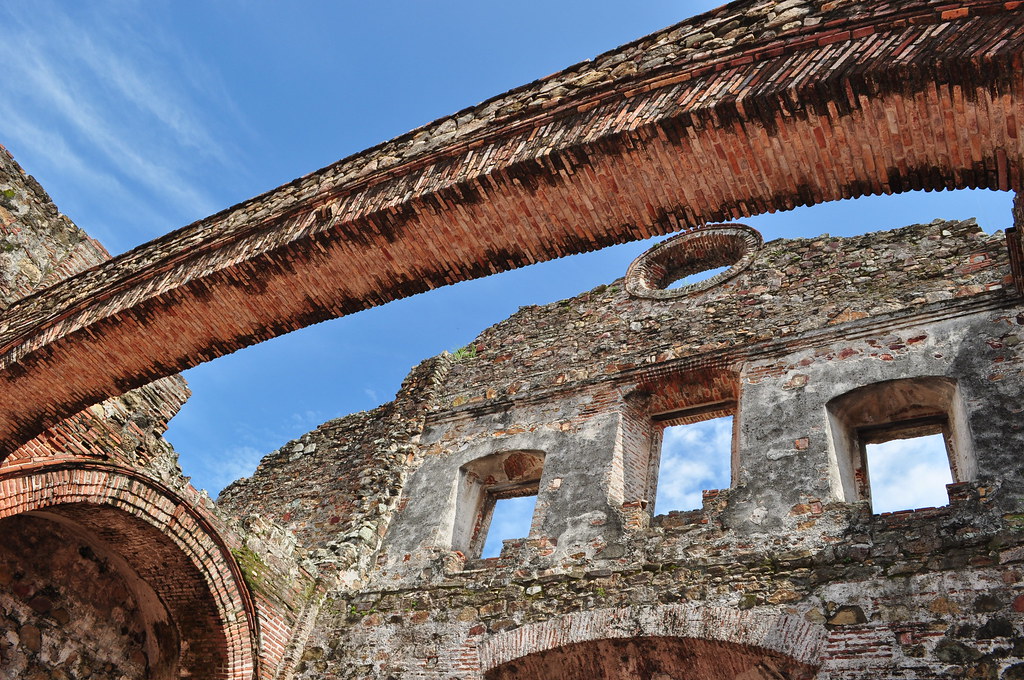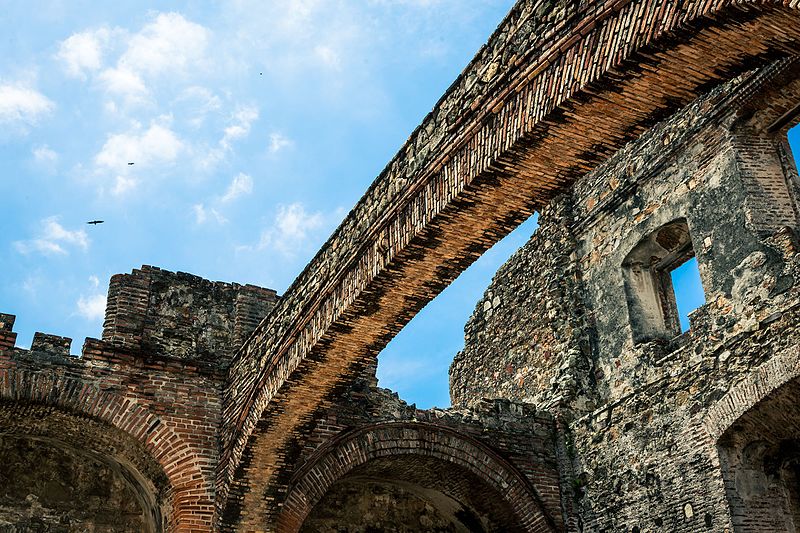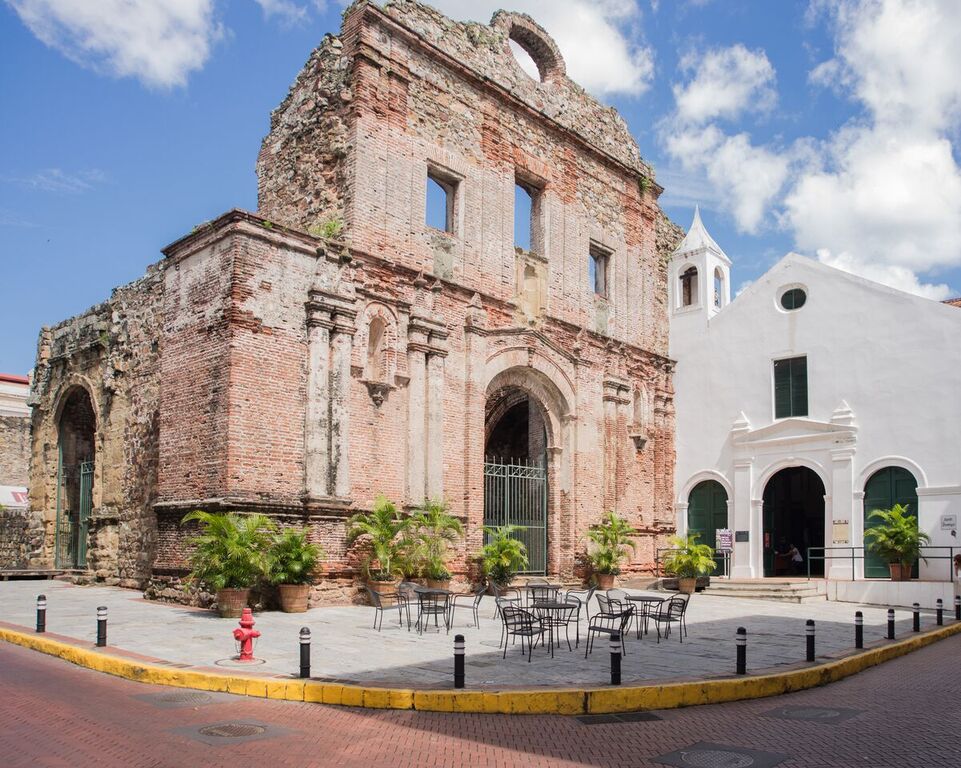The history of the Convent of Santo Domingo begins in the old city of Panama. Brother Domingo Perez arrived in 1571 with three other religious from the brotherhood to found his convent. He borrowed 3,000 pesos from his neighbor Jeronimo Suarez to buy a house with an orchard that would serve to lodge the friars. After the pirate attacks in 1671, the city of Panama Viejo was completely burned.
However, the history of the Dominicans begins earlier since they were the first friars to set foot on Panamanian lands. Dominican Father Andres de Vera was the chaplain of the expedition to discover the South Sea, on September 25, 1513, together with Vasco Nuñez de Balboa. The banana “plantain” was brought from the Canary Islands to Santo Domingo and Panama by the Dominican Brother Tomas de Berlanga.
Convent of Santo Domingo in Casco Viejo
Due to security issues, the new Governor Antonio Fernandez de Cordoba y Mendoza (1671-1673), decided to move Panama City to what is currently known as Casco Viejo. The Dominican friars also moved, building a chapel that gave mass for the first time in 1675. Three years later they already had their church and convent of Santo Domingo on the street that bore the same name, now called Avenida A.
The Dominicans lived a very quiet life, praying the rosary, walking in the cloister, planting gardens in their courtyards and talking. This religious order had many resources, which could be seen in the decorations, statues, furniture, paintings and architecture in general. The walls of the church were built of lime and stone, like many buildings in Casco Viejo. The ceiling, tribunes, choir and cloister were made of wood. It was made with a single nave, with eight side chapels.
Sadly, the Convent of Santo Domingo was a victim of the fires of 1737 and 1756. The fire of 1737 was very large and also burned the San Felipe Neri Church, the Metropolitan Cathedral of Panama, the San Jose Church and the Saint Francis of Assisi church.
The convents had to leave the country by order of Colombia when Panama joined Greater Colombia. In 1857 an auction was authorized to sell “the lot and the walls of the extinct church and convent of Santo Domingo.” It was bought by the Frenchman Jacques Joly de Sabla for 2,000 pesos. His son sold sections of the property to people who used them for residences. He preserved the facade of the temple including the flat arch and the chapel. The site and the cloister were used for commercial purposes, establishing businesses such as public toilets, carpentry workshop, barber shop, bakery and finally a bus station.

In 1925, President Rodolfo Chiari prohibited the demolition and sale of what had not been built from the ruins of the Santo Domingo Convent. Then in 1941, Law 68 was passed, which declared the site as a “national historical monument”. Finally, in 1981 the ruins were restored. Another site that is in ruins is the Society of Jesus, located just before on Avenida A.
Flat Arch
The most famous thing of the convent of Santo Domingo is its flat arch, which is really a lowered arch that was built to support the wooden choir that disappeared with the fire. Small bricks, common from the era, were used to build it. It has three points and is 50 feet long by 35 feet high.

No metal was used to support the flat arch, which defied the laws of gravity for more than 300 years. It even served to test Panama’s low seismic activity during the canal negotiations. Sadly, it collapsed on the night of November 7, 2003. On the floor you can see some of the original bricks. It was rebuilt using a metal beam inside and was lined with the original material.

Museum of Colonial Religious Art of Panama
Next to the ruin of the Convent of Santo Domingo is a white building, which looks like a small church, known as the Chapel of Santo Domingo de Guzman or the Chapel of the Rosary. The Dominicans venerated the Virgin of the Rosary. The chapel was built in the eighteenth century and restored in 1974. It is currently the Museum of Colonial Religious Art of Panama.

The most impressive thing is the altar with thin gold sheets attached to the wood with rabbit tail. The only original figures are the Virgin of the Rosary and the two cherubs. The image of Santo Domingo, with a black and white habit and a dog, and the image of the Virgin of the Immaculate Conception are found on the lower level of the altar. The church of San Jose also has a golden altar and they are considered brothers.
In the museum pieces from other churches are exhibited including that of San Francisco de la Montaña, San Felipe de Portobelo, Villa de Los Santos and the churches of Parita. Besides, they have pieces from South America, possibly from Quito, Ecuador or Lima, Peru. It is not known exactly since the records were burned. The hours of the Museum of Colonial Religious Art of Panama are from 9 a.m. to 5 p.m. Tuesday through Friday and 10 a.m. to 6 p.m. Saturdays and Sundays. It is closed on Mondays. The entry cost is one dollar.
[…] Chato: refers to the flat arch found in Convent of Santo Domingo. This suite has one queen bed sleeping two adults and a child can sleep on the sofa. It is set up […]